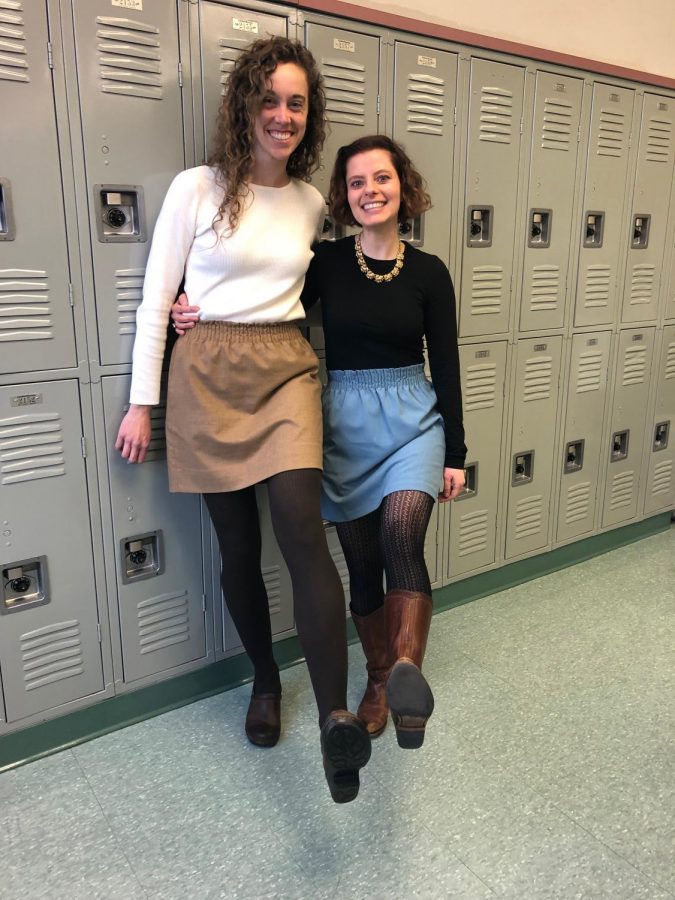Teachers bond in and out of the classroom
English teachers Julianne Abruzzo and Molli Atallah show off their matching outfits after school. The teachers co-sponsor the literary arts magazine and have formed a tight bond.
March 1, 2019
Walking into school on a Monday morning, unfinished homework in hand, your schedule includes tests, tests and more tests. With everyday stress like this, it is key to have a support system to lean on when times get tough. The same goes for teachers. As many different obstacles come with the occupation, it is important to find a group of people who make the challenging days manageable and to help find peace amid the chaos.
“Teaching is a rollercoaster of emotions,” English teacher Julianne Abruzzo said. “It is important to be aware of each other as more than teachers, but as people.”
Increased time spent at Chantilly is able to facilitate the development of stronger social relationships between colleagues.
“One of the great things about Chantilly is that a lot of teachers spend most of, if not all, their career here,” social studies teacher Charles Koch said. “That definitely makes a difference in your social relationships with those people.”
By spending so much time in school and sharing the experience of working with teenagers all day, teachers are able to connect with each other on a professional level.
“I would say the single person that I am closest to is Ms. [Stacey] Schweppe. We are both social studies teachers,” Angie Rollet said. “That certainly connects us here professionally, but I think our real bond is the outside connections. One of our main interests that really draws us together is baseball. We are baseball buddies; we go to games a lot together.”
Students often share different bonds that draw them together in their personal lives, but they may not realize that teachers do the same. In addition to sharing a career, some teachers have certain hobbies, interests or lifestyles in common.
“When [English teacher Molli Atallah and I] hang out outside of school and have dinner or dessert, we are like-minded in what we want to eat. We have a little vegan community because her husband is also vegan,” Abruzzo said. “It’s fun because when I bake, it’s nice to have people I can give it to. If I make something, I will bring extra to them and sometimes they’ll stop by with something for me.”
After spending hours with each other before, during and after school, some teachers become incredibly close, coming together for holidays and other important events.
“There is nobody who is more loyal or generous than Ms. Schweppe. She spends holidays with our family and attends my children’s birthday parties; she is just an adopted member of the family,” Rollet said. “They always say you can’t choose your family, but sometimes you can.”
Collaborating with others- not just students- is a major part of a teacher’s job. Some say it is especially helpful to work with someone who knows their strengths and shortcomings.
“Positivity Project talks about identifying strengths and weaknesses, and because we are friends and talk about our feelings, emotions and lives, we know what the other is good at and what we’re not good at,” Abruzzo said. “That translates really well to teaching, just in terms of actual content.”
Teachers inspire each other to use more creative and innovative teaching methods by collaborating and being unafraid to ask and receive help.
“I think it helps both personally and professionally,” Koch said. “It helps professionally because you’re very comfortable with asking people for help or assistance if you need it.”
According to the U.S. Department of Education, around 50 percent of new teachers leave their job after only five years. With having such a high burnout rate, support from colleagues can make all the difference.
“Teaching is a very unique job and there are a lot of unique circumstances that can happen in it, which sometimes necessitates that you need support from your colleagues and your friends,” Koch said. “They celebrate your good times and are always there to help you when you have crises in your personal life.”


